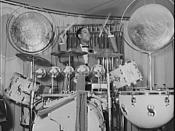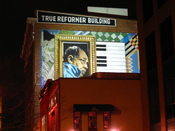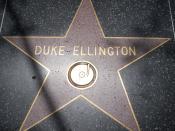Born on April 29, 1899, in Washington, D.C., he grew up among that city's substantial black middle class. His mother, Daisy Kennedy, was the daughter of a District of Columbia police captain. Daisy married the ambitious young James Edward Ellington, who was successively a coachman, butler, caterer, and blueprint draftsman. J.E., as Duke called his father, always acted as though he had money, whether he had it or not. He raised his family as though he were a millionaire Ellington had a happy childhood, from which he emerged strong and whole: He was an eager athlete, a bit of a bookworm, but not much interested in schoolwork. In the only music course that appears on his high school transcript, he got a D. But when he learned, as he later put it, that when you were playing piano there was always a pretty girl standing down at the bass clef end of the piano he dedicated himself to keyboard technique.
By his mid-teens, Duke (the nickname came from a snooty junior high school friend who liked to give his pals titles) was hanging out at Frank Holliday's pool room on T Street, a magnet for Pullman porters, pool sharks, and the city's best piano players. And the kid watched. And listened.
Soon he had his own band. Offered a scholarship to the Pratt Institute in Brooklyn (he was a visual artist of some promise), the eighteen-year-old Duke turned it down he was making too much money as a dance band entrepreneur, sending out four or five groups a night. In 1918 he married Edna Thompson. In 1919 a son, Mercer, was born. The marriage soon foundered, and though Duke and Edna never divorced, they rarely saw each other after the mid-twenties.
In 1923 Ellington and his fellow musicians Sonny Greer and Otto Hardwick ventured to New York, where they quickly began to starve. Hightailing it back to D.C. for some of Miss Daisy's cooking, they felt the pull of New York again after three months. This time they landed a gig at Barron Wilkins's Harlem cafe, playing what was then called conversation music, soft, sweet, and conventional.
Later in 1923 the group was offered a job on West 49th Street at the Hollywood Cafe, soon renamed Club Kentucky. Ten men strong now (they would eventually grow to sixteen); they were no longer playing conversation music but something weird and compelling. Dubbed jungle music for Sonny Greer is obsessively pounding tom-toms; it had little to do with Africa and everything to do with the African-American blues. Whatever you called it, the Ellington band's music sounded like nothing before or since.
Its singularity was rooted first in the musicians themselves, an unrivaled collection of musical eccentrics, one writer has called them and second in their boss's gift for combining and blending their idiosyncrasies into an even more striking whole. Trumpeter Bubber Miley's smears, groans, and wails, or the insinuating noises, like a cat in heat, that trumpeter Cootie Williams got from a plunger mute (the business end of a toilet plunger cupped over the horn's bell) in another band leader's hands; these sounds would have been mere barnyard effects, novelties. In Ellington's, they became the building blocks of high drama and sophisticated comedy.
Ellington's twin roles bandleader and composer were already thoroughly intertwined. For the rest of his life, the band was his indispensable composing tool, a great tone-painter's palette. Duke's later collaborator, Billy Strayhorn, put it best: Ellington plays the piano, but his real instrument is his band. In 1927 Duke and his men landed the house job at Harlem's mobster-owned Cotton Club, the epitome of Roaring Twenties chic. Playing nightly to slumming millionaires, the Ellington orchestra made its name. During his six years at the club, Duke wrote Black and Tan Fantasy, East St. Louis Toodle-Oo (with Miley), Creole Love Call, Mood Indigo, and other early masterworks. His persona was already established: unfailingly elegant, a master of suave flattery (my, you make that dress look beautiful was a favorite Ellington line). The real Duke was more complicated. His band member Rex Stewart, who later wrote several perceptive books, had this to say about his onetime boss: Ellington is the most complex and paradoxical individual I've ever known. He is completely unpredictable; a combination of Sir Galahad, Scrooge, Don Quixote, and God knows what other saints and sinners were apt to pop out of his ever-changing personality Ellington kept his inner self, or selves, well hidden. As his friend Irving Townsend said, Duke Ellington was seldom alone. Yet he was the most solitary and secretive man I ever knew If Ellington ultimately stayed aloof, it was to cultivate his ruling passion. There is a famous passage from his autobiography whose playful tone ends on a note of dead seriousness: roaming through the jungle, the jungle of 0oohs and ahhs, searching for a more agreeable noise, I live a life of primitively with the mind of a child and an unquenchable thirst for sharps and flats. The more consonant, the more appetizing and delectable they are. Cacophony is hard to swallow. Living in a cave, I am almost a hermit, but there is a difference, for I have a mistress. Lovers have come and gone, but only my mistress stays. Music is my mistress, and she plays second fiddle to no one.
In 1933 the Ellington orchestra sailed to England (despite Duke's fear of ocean travel) and played to ten solid minutes of applause at the world's most prestigious theater, the London Palladium (Ellington called the applause terrifying, it was applause beyond applause). Back in the United States, the band spent 1934ñ36 crisscrossing the nation. They were fine indeed, these dandies from the Apple. The novelist Ralph Ellison, then an Oklahoma City high school student and aspiring musician, describes the band's impact when it blew into his hometown:
The great orchestra came to town; came with their uniforms, their sophistication, their skills, their golden horns, their flights of controlled and disciplined fantasy; came with their art, their special sound; came with Ivie Anderson and Ethel Waters singing and dazzling the eye with their high-brown beauty and with the richness and bright feminine flair of their costumes, their promising manners. They were news from the great wide world, an example and a goal. Ellington had his own goals. In 1935 Reminiscing in Tempo took up both sides of two 78-rpm discs, an unprecedented length for a jazz work. Nothing quite that challenging had ever been attempted in jazz composition says the composer and jazz historian Gunther Schuller. This was music for listening and contemplation, not Lindy-hopping. The language of jazz, barely forged, was already being pushed, challenged, and extended to the horror of many jazz fans.
John Hammond, a talent scout and critic, argued in the jazz magazine Down Beat that [Ellington's] music is losing the distinctive flavor it once had Not only had Duke added slick un-Negroid musicians to his band wrote Hammond, but he has purposely kept himself from any contact with the troubles of his people or mankind in general . [He] consciously keeps himself from thinking about such problems as those of the Southern sharecroppers, the Scottsboro boys, intolerable working and relief conditions in the North and South. The Duke is afraid to think about himself, his struggles, and his disappointments. The irony of Hammond's last sentence is that Reminiscing was Ellington's response to the worst crisis he had yet encountered: his mother's death, which had thrown him into a depression. For Hammond, struggles meant social struggles only, not the more universal traumas of deep personal loss and a sudden face-to-face encounter with mortality.
Nor could Ellington be accused, at any point in his career, of ignoring his blackness. In a 1941 speech to black churchgoers in Los Angeles, he responded to Langston Hughes's poem Let America Be America Again (which Ellington mistakenly identified as We, Too, Sing America) by going Hughes one better. The poet's catalogue of Negro contributions to American history was too modest, said Ellington. The black man wasn't merely a builder of American civilization but more like the builder. Here was an astonishing, and astonishingly early, voicing of a theme that gained currency only decades later, in the writings of Ellison and the social critic Albert Murray: Negro is the creative voice of America, is creative America, said Duke. We kept alive [Americanism] flickering conscience, prodded her on toward the yet unachieved goal, democracy until we became more than a part of America! We, this kicking, yelling, touchy, sensitive, scrupulously-demanding minority are the personification of the ideal begun by the Pilgrims. We are more than a few isolated instances of courage, valor, and achievement. We're the injection, the shot in the arm that has kept America and its forgotten principles alive. Nor was he just speechifying. Plenty of Ellington's works of the day Jump for Joy (1941), Black, Brown and Beige (1943), and many others were frank celebrations of African-American identity in a day when such celebrations were rare indeed.
In the years just before 1940 Duke began three important relationships. Beatrice Evie Ellis became his companion for the rest of his life; the physician Arthur Logan became his personal doctor and best friend (on whom the Duke, a confirmed hypochondriac, came utterly to depend); and he acquired a collaborator, the composer and arranger Billy Strayhorn, who wrote the band's theme song, Take the A Train. When America entered World War II, Ellington was at the peak of his popularity and making his best music yet. Rarely has American popular musical taste dovetailed so completely with works of genius: Koko (as perfect a composition as the three-minute limit of the 10-inch 78-rpm phonograph record would permit says Gunther Schuller), Cotton Tail, Do Nothing Til You Hear From Me (the vocal version of Concerto for Cootie), and Never No Lament (the instrumental version of Don't Get Around Much Anymore). By 1943 Ellington's eleven hundred recordings had sold twenty million copies. And on he rode, through the war years. As the fifties began, the decline of big bands, the rise of rhythm and blues, and the first premonitions of rock -n- roll caused a slump in Duke's fortunes. In 1951 three great sidemen, the alto saxophonist Johnny Hodges, the drummer Sonny Greer, and the trombonist Lawrence Brown, all quit (though Hodges and Brown later rejoined). Satin Doll in 1953 was Ellington's last hit single.
But you couldn't ever count the Duke out. In 1956 a spectacular solo by the tenor saxophonist Paul Gonsalves sparked near-pandemonium at the Newport Jazz Festival, catapulting Ellington onto the cover of Time. Suddenly Duke was as visible as ever. His final incarnation arrived: the coolly amused, persistently polite, impregnable aristocrat as Nat Hentoff put it in 1965. He was an international figure now, nation-hopping on State Department-sponsored tours; the old whistle-stops replaced by airports the world over. When a reporter asked him if he would ever quit the road, Ellington smiled and said, what would I do sitting in one place? I'm in contact every night with people olive people listening to my music. What reason would I have to retire from the road? Watch him some night in the wings said a band member. Those bags under his eyes are huge, and he looks beat and kind of lonely. But then we begin to play, he strides out on the stand, the audience turn their faces to him, and the cat is a new man. The road was burned into his soul; for all his aloofness, he thrived on the daily contact with musicians, audiences, friends in cities everywhere.
Some argue that this restlessness prevented Ellington from fully realizing his genius. Had he been able to sit still, they say, he might have accomplished the one goal that eluded him: the mastery of big, extended musical forms. He knew it was a dream he would never realize writes Schuller, adding that Ellington was too distracted willingly by the crush of one-night stands to acquire the technical skills and to muster the quiet concentration that larger works require. The big concert pieces, from Creole Rhapsody in 1931 through 1943ÃÂs Black, Brown and Beige to the suites and religious works (Ellington called them Sacred Concerts) that took up more and more of his time from the fifties on, were failures, collages of unrelated, if glowing, material. Or that is what one camp maintains, insisting that Ellington reached his creative apogee with his great three-minute hits of the early forties.
Wrong, insists the other camp. Wynton Marsalis devoted an entire segment of his recent radio series, making the Music to a close reading of Ellington's Tone Parallel to Harlem and argued persuasively that that work, commissioned by Toscanini and the NBC Symphony Orchestra in 1951, is a completely successful large work, its themes subtly developed, and its organic unity complete. Far from reaching his artistic height in the 1940s, says Marsalis, Ellington kept right on evolving. In 1967 Billy Strayhorn died (Duke responded with one of his finest albums, And His Mother Called Him Bill), followed in 1970 by Ellington's greatest sideman, the irreplaceable Johnny Hodges. When Arthur Logan died, in late 1973, Duke cried himself to sleep. I don't know what I'm going to do he told Logan's widow. I won't last six months
He didn't. He died on May 24, 1974, writing music until almost the very end. On May 27 ten thousand mourners gathered at the Cathedral of St. John the Divine on the outskirts of Harlem. One of the speakers, the British journalist Alistair Cooke, summed up the crowd's, and the worlds, emotions. Paraphrasing the novelist John O'Hara's reaction to the death of George Gershwin, Cooke said, Duke Ellington died last week. I don't have to believe it if I don't want to.
Ellington's impact on America wasn't just musical. Here, to use that belabored phrase, was an incomparable role model. The composer Robert Crowley saw the Duke as a public hero along the lines of Franklin D. Roosevelt. in his expansive zest for life, his resilience, his perennially unexpected response to events, and his creative execution of everyday tasks said Crowley, I[Ellington] set an example of human potentialities for thousands, make that millions of people. Especially African-American people. Though Ralph Ellison was writing about the Ellington orchestra in what follows, his words apply best of all to its leader: I wish that all those who write so knowledgeably of Negro boys having no masculine figures with whom to identify would consider the long career of Ellington and his band, the thousands of one-night stands played in the black communities of this nation. Where in the white community, in any white community, could there have been found images, examples, such as these? Who were so worldly, who so elegant, who so mockingly creative? Who so skilled at their given trade and who treated the social limitations placed in their paths with greater disdain? But in the end, of course, it is Ellington's music that will be remembered. Twenty-five years after his death, a century after his birth, the Duke's works are being played all over the world. Like all great artists, Ellington took an idiom laying close at hand the down-home blues of Southern African-Americans and crafted it into something so sensuous, elegant, and dramatic that people everywhere respond, and will keep responding, deeply.


